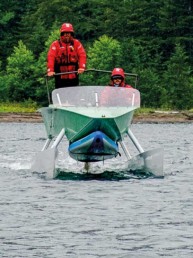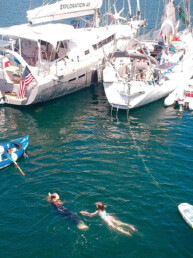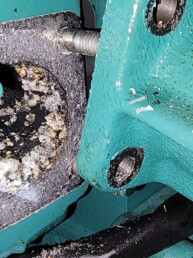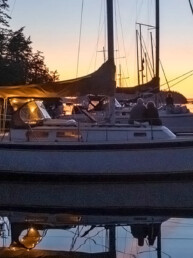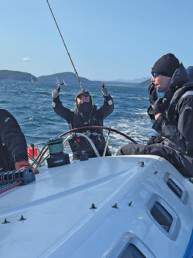This article was originally published in the November 2021 issue of 48° North
North Head is a perfect example of an iconic lighthouse. Rugged and isolated setting? Check. White tower overlooking an endless expanse of ocean? Check. Steep cliffs plunging into thunderous surf? Check. Violent storms and shipwrecks? Check. Ghost stories? Check. While it might look like something from the windswept coast of Cornwall — the backdrop for a Daphne du Maurier novel — the North Head Lighthouse is located in southwestern Washington, near the mouth of the Columbia River.
Cape Disappointment Lights
The North Head Lighthouse went into service in 1898, reflecting an era of increased vessel traffic and commerce on the Pacific Coast. It was not the first light constructed on Cape Disappointment. Another beacon was placed two miles south in 1856, before the U.S. Civil War, to guide ships through the massive waves and shoals of the Columbia Bar — that treacherous patch of water where the powerful river meets the Pacific Ocean. So numerous were the shipwrecks on this stretch of coast that it became known as the “Graveyard of the Pacific.”
The Cape Disappointment Lighthouse, which was Washington’s first, was an improvement over the system of notched trees and nighttime fires that previously guided ships, but it was not visible to mariners approaching from the north. Moreover, its fog bell could not be heard over the roar of the surf. In 1898, its first-order lens — the most powerful — was moved to the new North Head Lighthouse, which stood higher than the older tower at 65 feet above the ground and 194 feet above the ocean. These two lighthouses, located so close together, featured different signals. The North Head tower flashed a fixed white light, while the signal for the nearby Cape Disappointment beacon alternated red and white.
Architecture and Technology
![]() Designed by prolific lighthouse architect Carl W. Leick and built by George Langford, a contractor from Oregon, the lighthouse was made of dressed stone lined with brick. A railing surrounded the lantern at the top of the tower, which housed a Fresnel lens, named for the French physicist who invented it. This was a large, heavy device featuring a series of concentric circles that projected a powerful beam of light. In lighthouse lore, the Fresnel lens is known as “the invention that saved a million ships”. Inside the tower, a spiral staircase wound upward to the lantern and watch area. As a coastal lighthouse, North Head featured an especially tall tower that could be viewed from a distance at sea. In contrast, some towers along Puget Sound measured only 40 feet in height.
Designed by prolific lighthouse architect Carl W. Leick and built by George Langford, a contractor from Oregon, the lighthouse was made of dressed stone lined with brick. A railing surrounded the lantern at the top of the tower, which housed a Fresnel lens, named for the French physicist who invented it. This was a large, heavy device featuring a series of concentric circles that projected a powerful beam of light. In lighthouse lore, the Fresnel lens is known as “the invention that saved a million ships”. Inside the tower, a spiral staircase wound upward to the lantern and watch area. As a coastal lighthouse, North Head featured an especially tall tower that could be viewed from a distance at sea. In contrast, some towers along Puget Sound measured only 40 feet in height.
Like many light stations, North Head is more than just a tower. Two small buildings for storing kerosene stood nearby, kept separate from other structures owing to flammability. Also included was a keeper’s home, a duplex to house the assistant keepers, a barn and chicken coop, and a cistern.
Light Keepers
For all its technological and architectural significance, the North Head Lighthouse is famous for its keepers. Alexander K. Pesonen, a Finnish immigrant, was the first. For more than 20 years, he oversaw the maintenance of the station — a job requiring constant vigilance. Responsibilities included trimming lamp wicks, hauling fuel up the spiral stairs, filling the lamp reservoirs, and polishing lenses. The property, which included several residences and animals, also needed managing. In addition, Pesonen kept logs recording weather and
listing supplies. His work was subject to inspection by the Lighthouse Service.
If that was not enough, Pesonen contended with a brutal environment. Gale force winds frequently pummeled the light station, imperiling its structures as well as ships close to shore. And not all the local creatures were friendly. In the summer of 1903, for instance, as Pesonen walked along a plank road near the lighthouse, he encountered an enormous black bear who refused to let him pass. According to an article in The Seattle Daily Times, the creature “stood on his hind feet and showed his teeth.” Pesonen’s dog came to the rescue, and the
barking “caused his bearship to change his mind and shamble off into the brush.”
Pesonen’s notoriety did not end here. Early in his career he married Mary Watson, a native of Ireland. For several decades they lived at the light station with various assistant keepers, one of whom was Mabel Bretherton, a widow who had been transferred to North Head after serving at an Oregon lighthouse. By the early 1920s, Mary had been diagnosed with melancholia, a condition similar to depression. One June morning in 1923, she went for a walk with the dog and never returned. Pesonen began searching for Mary when the dog showed up at the light station alone and agitated, eventually finding her coat lying on the ground above a cliff. Mary’s body was discovered on the rocks below. The assumption, according to The Seattle Daily Times, was that she had leapt to her death intentionally, with the dog later guiding searchers to the “fateful spot”.
Over the years, Mary’s death has become part of the lore of North Head, attracting paranormal investigators who claim the station is haunted by her spirit. Questions about ghostly activity aside, it is clear that life at the isolated station could be tense and unhappy — a pervasive theme in stories about remote lighthouses. The film The Lighthouse (2019), for instance, explores two keepers living on the edge mentally as well as physically, with the harsh natural environment reflecting the deteriorating psychological state of the men. Set in stunning locations, light stations may seem as romantic as a du Maurier novel, but living there could be difficult and dangerous.
Visiting the North Head Lighthouse
![]() Today, the North Head Light is owned and operated by Washington State Parks at Cape Disappointment. For mariners, it can signal refuge if the bar is crossable. If the bar is closed, it’s a symbol of safe harbor frustratingly just out of reach. Southbound sailors in good weather generally love its visage, though we can’t recommend you explore the waters around it close up in any but the most benign conditions. If approaching the Columbia by passing North Head at night, look for two white flashes every 30 seconds, separated by 7.5 seconds.
Today, the North Head Light is owned and operated by Washington State Parks at Cape Disappointment. For mariners, it can signal refuge if the bar is crossable. If the bar is closed, it’s a symbol of safe harbor frustratingly just out of reach. Southbound sailors in good weather generally love its visage, though we can’t recommend you explore the waters around it close up in any but the most benign conditions. If approaching the Columbia by passing North Head at night, look for two white flashes every 30 seconds, separated by 7.5 seconds.
North Head Lighthouse remains a “very significant” draw for shoreside visitors to the Long Beach Peninsula, explained Evan Roberts, Park Area Manager, recently. “Lighthouses offer spectacular ocean views, wildlife, and maritime history.” Visitors can access the grounds of the station, and the tower interior is sometimes open for viewing. Visitors can also reserve overnight stays at the keeper’s house.
Access and availability vary; check the Washington State Park website for information:
parks.state.wa.us/486/Cape-Disappointment

